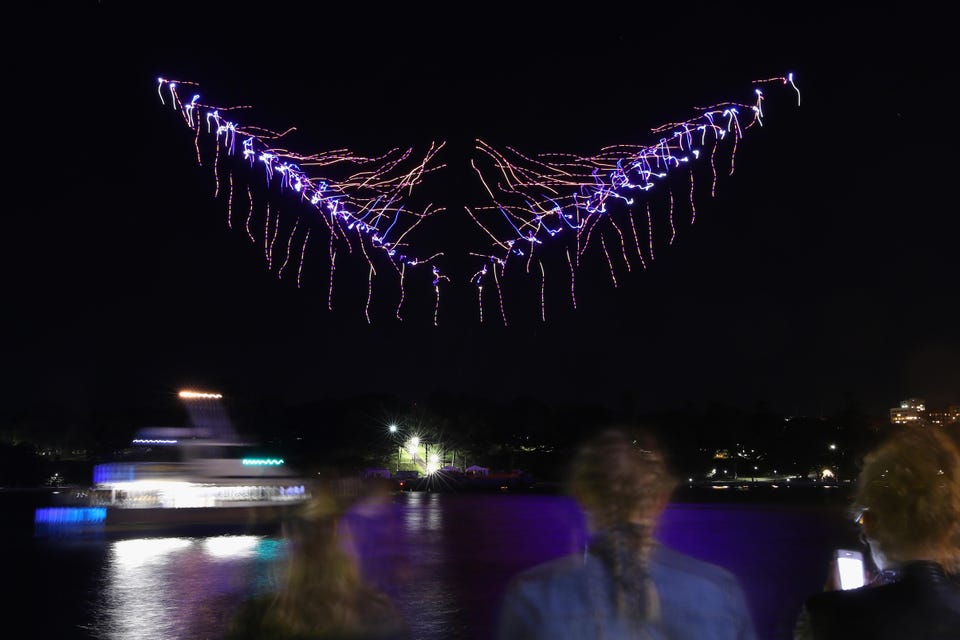Science It Would Cost $65 Million To Display 60-Second Commercials In Twilight Above Cities. What A Disgusting Idea Jamie Carter Senior Contributor Opinions expressed by Forbes Contributors are their own. I inspire people to go stargazing, watch the Moon, enjoy the night sky Following New! Follow this author to stay notified about their latest stories.
Got it! Oct 9, 2022, 04:03am EDT | New! Click on the conversation bubble to join the conversation Got it! Share to Facebook Share to Twitter Share to Linkedin SYDNEY, AUSTRALIA – JUNE 08: 100 illuminated drones perform a choreographed routine over Sydney . . .
[+] Harbour accompanied by Beethovens Fifth Symphony performed by Sydney Youth Orchestra on June 8, 2016 in Sydney, Australia. Vivid Sydney is an annual festival that features light sculptures and installations throughout the city. The festival takes place May 27 through June 18.
(Photo by Cameron Spencer/Getty Images) Getty Images Light pollution is a serious problem for humanity and it’s getting worse. The creep of LED lights across the world in the past decade or so has caused skyglow to increase, so much so that urban stargazing is becoming much more difficult. Now another insidious kind of light pollution is being talked up in a recent study published in the journal Aerospace .
It looks at the possibility of a space advertising mission. Yes, that’s right—advertising in the night sky. The researchers from Skoltech, a private university Moscow, Russia, studied the economic feasibility of launching a bunch of satellites into orbit to fly in formation and reflect sunlight to display commercials in the sky above cities.
This is surely the ultimate definition of space junk. “As unrealistic as it may seem, we show that space advertising based on 50 or more small satellites flying in formation could be economically viable,” said Shamil Biktimirov, co-author and a research intern at Skoltech’s Engineering Center. They arrived at a tentative cost of $65 million.
The concept uses small CubeSats that nevertheless each unfurl a 32-square-meter solar sail to maximize reflectiveness, though since they reflect sunlight they would only work in the hour or so after sunset (or before sunrise). MORE FOR YOU Juan Soto Contract Rejection Could Make Orioles A Better Buy Than Nationals Wall Street’s Friday Night Frights – Ignore Them The NBA 2K23 MyTeam Card That Is Going To Change The Mode There are various factors involved that affect how much money could be made, from the cloudiness to the demographics of the city the commercials are shown to. The model works by picking the most profitable city within reach and displaying an ad there for one minute before switching to the next one.
So perhaps only big cities—already blighted by light pollution—would be visited by these monstrosities. There are two aspects of this concept to be worried about. The first is that the study finds space advertising to be commercially viable.
The authors show that space advertising revenue could reach approximately $2 million per day for a series on one-minute commercials over a profitable city. So the mission would only have to last just over a month to break even. The researchers claim that such a mission could operate for several months.
The second is the researchers cavalier attitude to light pollution. In the paper the researchers state that light pollution concerns is unwarranted since commercials could only be shown around sunrise or sunset—and not at night—and that it would only make economic sense to show commercials to large cities that are already exposed to permanent light pollution. For example, they wouldn’t be visible from anywhere that observatories study the night sky.
This is both massively disrespectful to people in cities, hugely damaging to wildlife that live in them and completely misunderstands the value of twilight. No, professional astronomy is not done in cities. So what? There are plenty of urban astronomers.
I would argue that the majority of amateur astronomers live in cities. Yes, y ou can go stargazing in London . Go up to the High Line in Manhattan and you’ll find members of the Amateur Astronomers Association of New York looking at stars, planets and galaxies.
The last thing the iconic Griffith Observatory in Hollywood, Los Angeles needs is yet more light pollution in the form of logos for car companies or fast food brands. Twilight is a gorgeous and incredibly important time. It’s when the birds roost and the stars come out.
It’s a time for looking for planets low on the horizon and for spotting a crescent Moon. It’s when night’s window opens and always has done. Commercials are for TVs, not twilight.
Wishing you clear skies and wide eyes. Follow me on Twitter or LinkedIn . Check out my website or some of my other work here .
Jamie Carter Editorial Standards Print Reprints & Permissions.
From: forbes
URL: https://www.forbes.com/sites/jamiecartereurope/2022/10/09/it-would-cost-65-million-to-display-60-second-commercials-in-twilight-above-cities-what-a-disgusting-idea/
